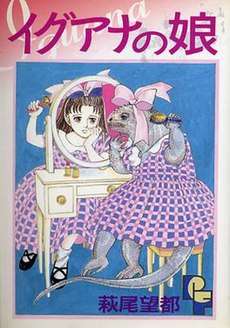Iguana Girl
Iguana Girl (Japanese: イグアナの娘, Hepburn: Iguana no Musume, also translated as Daughter of the Iguana or Iguana Daughter) is a Japanese one-shot manga written and illustrated by Moto Hagio. It was published in Petit Flower magazine in 1992 and adapted into a television drama in 1996.
| Iguana Girl | |
 Cover of Iguana Girl featuring Rika | |
| イグアナの娘 (Iguana no Musume) | |
|---|---|
| Genre | Drama |
| Manga | |
| Written by | Moto Hagio |
| Published by | Shogakukan |
| English publisher | Fantagraphics |
| Magazine | Petit Flower |
| Demographic | Josei |
| Published | May 1992 |
| Volumes | 1 |
| Television drama | |
| Original network | TV Asahi |
| Original run | 15 April 1996 – 24 June 1996 |
| Episodes | 11 |
It is about a young girl, Rika, whose mother views her as being ugly, and favours her other daughter, Mami. Rika thinks of herself as ugly and as an iguana, but after her mother's death, realises that her mother was also an ugly iguana.
Iguana Girl reflects Hagio's own relationship with her mother,[1] and it took her "years to write this story". Hagio saw an iguana in a documentary on television and identified with it, feeling it was "lamenting its failure to become a human, just like me".[2]
Media
Manga
The short story was first published in the May 1992 issue of Shogakukan's josei manga magazine Petit Flower.[3] Shogakukan delivered the tankōbon release not until 1994,[4] and it benefited a re-edition in 2000.[5] It was translated into English and published in the Moto Hagio anthology A Drunken Dream and Other Stories by Fantagraphics in 2010.[6]
Television drama
The screenplay was by Kazue Okada, and the episodes were directed by Kazuhisa Imai and Shinjo Takehiko. The cast included Miho Kanno, Yoshinori Okada, Rena Komine, Hitomi Sato, Koji Yamaguchi, Miyuki Komatsu, Takeshi Izawa, Kanako Enomoto, Naomi Kawashima and Masao Kusakari. The theme tune to the series is Elton John's "Your Song".[7] The television drama was released on DVD in 2001.[8]
| Ep# | Title[7] | Director[7] | Original air date[7] |
|---|---|---|---|
| 1 | (Japanese: のろわれた誕生) | Kazuhisa Imai | 15 April 1996 |
| 2 | (Japanese: わたし死にたい…) | Kazuhisa Imai | TBA |
| 3 | (Japanese: 高原の夜、初めての…) | Shinjo Takehiko | TBA |
| 4 | (Japanese: お母さんの秘密…) | Shinjo Takehiko | TBA |
| 5 | (Japanese: 誕生日…母に捨てられたプレゼント) | Kazuhisa Imai | TBA |
| 6 | (Japanese: 波紋、母が呼んだ家庭教師…) | Kazuhisa Imai | TBA |
| 7 | (Japanese: 母の告白…あなたを殺したい) | Shinjo Takehiko | TBA |
| 8 | (Japanese: 永遠の友情、死、そしてもう一人の母) | Shinjo Takehiko | TBA |
| 9 | (Japanese: 幸せになる権利…) | Kazuhisa Imai | TBA |
| 10 | (Japanese: 悲しい家族旅行…) | Shinjo Takehiko | TBA |
| 11 | (Japanese: お母さん!お母さん!…おかあさん!) | Kazuhisa Imai | 24 June 1996 |
Reception
George Gustines, writing for the New York Times on great graphic novels for 2010, called Iguana Girl "oddly appealing and surprisingly bittersweet".[9]
References
- Thorn, Rachel Matt. "The Moto Hagio Interview conducted by Matt Thorn". Rachel Matt Thorn. Archived from the original on 2012-04-13.
- Kawakatsu Miki. "Iguana Girl Turns Manga Legend" (PDF). Japanese Book News Vol. 63. Retrieved 2010-06-03.
- イグアナの娘. Kotobank (in Japanese). The Asahi Shimbun Company. Retrieved 21 June 2020.
- イグアナの娘 / 1 (in Japanese). Shogakukan. Retrieved March 28, 2010.
- イグアナの娘 (in Japanese). Shogakukan. Retrieved March 28, 2010.
- Thorn, Rachel Matt (March 9, 2010). "Moto Hagio collection, Takako Shimura's "Wandering Son"". Rachel Matt Thorn. Retrieved March 28, 2010.
- "イグアナの娘 1996年4月クール連続ドラマ MMJ メディアミックス・ジャパン 映像制作 ドラマ制作 ドラマセミナー" (in Japanese). mmj-pro.co.jp. Archived from the original on July 22, 2011. Retrieved March 28, 2010.
- https://www.amazon.co.jp/dp/B00005MIHB
- "Graphic Novels and Comics - Gift Guide 2010". The New York Times. 12 November 2010.
Further reading
- Clements, Jonathan; Takamuro, Motoko (2003) The Dorama Encyclopedia Stone Bridge Press ISBN 978-1-880656-81-5